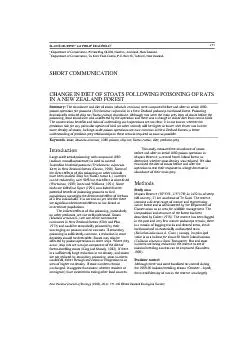/


rant have switched to eatin g other food sourcesThis study measured the abundance of stoatsbefore and after an aerial 1080 poison operation in p re Study areaMapara Reserve 38 ID: 180791
Download Pdf The PPT/PDF document "Department of Conservation, Te Kuiti Fie..." is the property of its rightful owner. Permission is granted to download and print the materials on this web site for personal, non-commercial use only, and to display it on your personal computer provided you do not modify the materials and that you retain all copyright notices contained in the materials. By downloading content from our website, you accept the terms of this agreement.
Department of Conservation, Te Kuiti Field Centre, P.O. Box 38, Te Kuiti, New Zealand.(sodium monofluoroacetate) is used to control1973) and could be secondarily poisoned by their rant) have switched to eatin g other food sources.This study measured the abundance of stoatsbefore and after an aerial 1080 poison operation in p re Study areaMapara Reserve (38°33'S, 175°17'E) is 1432 ha of steephill country, 27 km southeast of Te Kuiti. The reservecontains a diverse range of mature and regeneratingfor wildlife management. Thecomposition and structure of the forest has beenin the past and very few mature podocarps remain; thereis a mosaic of logging tracks and cleared areas, shrubA. Cunn.) canopy. Its principalvalue is as a habitat for about 50 North Island kokako(Callaeas cinerea wilsoni Bonaparte). Rat and stoatnumbers are being reduced in the reserve to see ifkokako breeding success can be improved (Saunders,1990).Predator controlAlthough there was some localised rat control during N ew Zealand Journal of Ecology (1992) 16(2): 137-140 ©New Zealand Ecological Society 150 to 300 m apart, were set for 182 days from 15 j uveniles. Females were classed as juveniles or adultsby measuring the post-orbital ratio (interorbital widthbreeding season, 23 stoats were trapped of which 20were autopsied. Of those, three had empty guts andFor the diet analysis, the contents of the stomachand intestine were washed in a 0.5 mm sieve and storedor diagnostic feather patterns. Remains of egg shells andinvertebrates were noted but not further identified.(Mus musculus L.), rats (Rattus spp.), orlagomorphs (rabbits or hares) from bones, teeth or hairResults of the diet anal y sis are p resented as afrequency of occurrence, i.e., the percentage of gutswith food that contained each prey item. Thecomposition of the diet by weight was also estimated byexpressing the numerical occurrence of each preymethod of King and Moody (1982). Invertebrates,mostly wetas (Orthoptera), were weighted as 3 g, miceResultsAbundance, age and sex ratioThere was an obvious decline in rat captures after theaerial poison operation, particularly during the first 3.51989-90 and 1990-91, 17 stoats were caught in eachseason (0.15 and 0.11 captures per 100 trap nightsrespectively).There was no significant change in the proportionof juvenile and adult stoats trapped between the twofemales: 2 = 0.21, d.f.=1, P � 0.1; males: X2 = 0.02,d.f.= 1, P � 0.1).Table 1: Number of animals Fenn-trapped at Mapara from 15October 1989 to 15 April 1990, and 15 October 1990 to 15 A Age category1989-901990-91Juvenile females6 (29%)8 (25%) Adult females3 (14%)6 (19%)Juvenile males7 (33%)10(31%)Adult males5 (24%)8 (25%) MURPHY and BRADFIELD: STOAT DIET CHANGE AFtrapped over the two kokako breeding seasons. In 1989- hilomelos Brehm), one was not identifiable (but notPasseriformes) and one was not identifiable. The X = 0.01, d.f.=1, P � 0.1, invertebrates, X2 = 0.2, d.f.= 1, P � 0.1).Table 4 gives an estimate of the composition byweight of the diet for the two study periods. The resultsfollowing the aerial poison operation and rats a muchlower proportion. If the four pigeons identified in theTable 3: Percentage frequency of occurrence of preyidentified in stoat guts collected from 15 October 1989 to 15 A 1989-90 1990-916 06560 66 6 140NEW ZEALAND JOURNAL OF ECOLOGY, VOL. 16, NO.2, 1992Although our study was only a preliminary one(and replication was not possible), our findings are ofconsiderable importance to conservation management,showing as they do the importance of understanding thebirds. The answer for kokako may be different to thatfor hole-nesting birds such as kaka (Nestor meridionalisGmelin), which may be more susceptible to predation(Felis catus L.) are theother common carnivore in New Zealand forests (Gibbtheir diet (Fitzgerald and Karl, 1979), they could besimilarly affected by aerial 1080 poison operations.Large-scale poison operations to control possumsare undertaken regularly in New Zealand forests. It istherefore important to gain a detailed understanding ofpredator-prey relationships in these systems, and tos p ecies, of undertakin g such o p Gibb, J.A.; Flux, J.E.C. 1973. Mammals. 437443.King, C.M.; Moody, J .E. 1982. The biology of the stoat ort, Christchurch, N.Z. 14 pp . ementsWe thank Landcare Research New Zealand Ltd., Ilamand the Zoology Department of Otago University foruse of their laboratory facilities; Malcolm Thomas forcomments on drafts of this paper.ReferencesClout, M.N.; Gaze, P.D.; Hay, J.R. 1988. Clutch overlapby a New Zealand pigeon. Notornis 35: 59-62.Coker, P.M. 1978. Status of the kokako in Mapara S.F.and adjacent forest. Fauna Survey Unit Report No.11, New Zealand Wildlife Service, Department ofInternal Affairs, Wellington, N.Z. 5 pp.Cowan, P.E. 1990. Brushtail possum. In: C.M. King(Editor), The handbook of New Zealand mammals,pp. 68-98. Oxford University Press, Auckland,Day, M.G. 1966. Identification of hair and featherremains in the gut and faeces of stoats and weasels.Journal of Zoology (London) 148: 201-217.